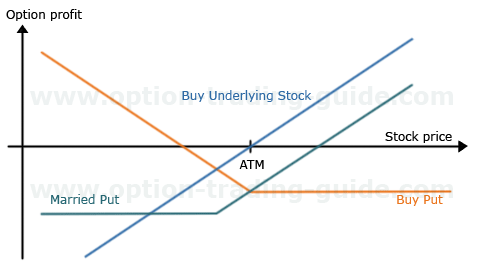Protective Puts
Post on: 24 Апрель, 2015 No Comment

Beginning Option Strategies/Hedging
Protecting Your Portfolio with Puts
Andrea Kramer (akramer@sir-inc.com)
This article explains how shareholders can guard their positions against a downturn by purchasing protective puts.
What is a put? A put buyer has the right to sell the underlying stock at a predetermined price (strike) within a certain window of time (until options expiration). Put purchasers are typically bearish on the stock, and expect the underlying shares to fall beneath the strike price before options expiration. However, protective put buyers have an ulterior motive for employing these options: portfolio insurance.
Who should tune in? The protective put buyer will already own at least 100 shares of the underlying stock. As such, he�s still bullishly biased on the security, but wants to protect against a potential pullback on the charts. By purchasing a put on the stock, the investor is simply guaranteeing a minimal selling price (put strike) for his stake, should the shares retreat before options expiration.
How does it work? Like any form of insurance, the �policy holder� must pay a premium for coverage. To initiate a protective put play, the investor would purchase a put on the stock he�s attempting to insure. The put strike should correlate with the minimal price the shareholder is comfortable unloading his shares of the stock, while the expiration date should tie in with his expected length of �portfolio coverage.�
In other words, if the trader wants to insure that he receive no less than $100 per share for his stake in a stock, he would buy a 100-strike put. In addition, if he wants to guard against a potential pullback through March 2010, he would purchase a March-dated put.,/p>
What�s in it for me? Typically, only option sellers would want the option to expire worthless, allowing him to pocket the initial credit. However, this isn�t the case with the protective put strategy.
Since the investor is a shareholder first and option buyer second, his primary objective is still for the underlying stock to journey higher. Therefore, the protective put buyer�s main goal is for the shares to muscle into the black, leaving the put worthless at expiration. However, should the shares take a turn for the worse before expiration, the purchased put guarantees a minimal selling price for the stock owner.
What do I have to lose? Again, any form of insurance is going to cost you something. In this case, should the underlying stock trek higher, the protective put purchaser will have to forfeit the initial debit paid, which represents the most he can possibly lose. However, the loss incurred by the option is a small price to pay for portfolio protection (and a good night�s sleep, in many cases), especially if the underlying shares rally past breakeven (stock price at initiation + premium paid for put) by expiration. In this best-case scenario, the underlying stock�s gains will entirely offset the cost of the put.
(Don�t forget to include any brokerage fees, margin requirements or commission costs. )
Let�s look at an example
Meet Jack, a veteran stock trader who�s recently tried his hand at options. In January, Jack purchased 100 shares of XYZ for $30 apiece, of $3,000 total. The stock has since skyrocketed to the $55 region, but is now challenging long-term resistance. In fear of a potential pullback on the charts, Jack opts to buy a protective put on his XYZ position.
The least Jack is willing to accept for his XYZ stake is $50 per share, or $5,000 total. Since his original investment was $3,000, buying a 50-strike put would guarantee he achieves a gain of $2,000 (minus the cost of the put) on his position.
Meanwhile, since Jack is nervous about a pullback in the intermediate term, he opts to purchase a January 2010 put on XYZ. This will protect his stock position from an unexpected decline through January options expiration.
As such, Jack opts to buy the XYZ January 50 put, which last crossed the tape for $1.10, or $110 (x 100 shares). This represents the most he can possibly lose on the option position. In order to avoid a loss, however, Jack needs the shares of XYZ to finish at or above the $56.10 level (stock price at initiation + premium paid for put) by January expiration. In this instance, the gains from his stock position will fully cover the initial premium paid for the protective put.
Fast-forwarding to January options expiration, let�s assume Jack�s worst fears ring true and the shares of XYZ tumble to the $45 level. By exercising his January 50 put, he can unload his 100 shares of XYZ for $50 apiece, or $5,000 total. Had he not purchased the �insurance,� Jack�s XYZ stock position would be worth only $4,500 total � a $500 discount to his sale price with the put protection.
On the other hand, let�s assume the shares of XYZ barrel through potential resistance, skyrocketing to the $60 level by January options expiration. In this case, Jack�s January 50 put would expire worthless, meaning he would have to forfeit the initial premium of $1.10, or $110, paid for the protective put. However, since his stock position is up $500 ($6,000 — $5,500) from the time the put was purchased, the premium paid for the put is fully covered, and Jack still gets to bask in the glory of his portfolio gains.
In conclusion
Buying protective puts is similar to implementing a stop-loss plan on your stock position. By purchasing this portfolio protection, you can guarantee a minimal price to unload your stake in the wake of an unexpected retreat. And, while you�ll have to forfeit the initial premium paid should the underlying stock journey higher, the cost of the �coverage� is a small price to pay to sleep a little better at night.














